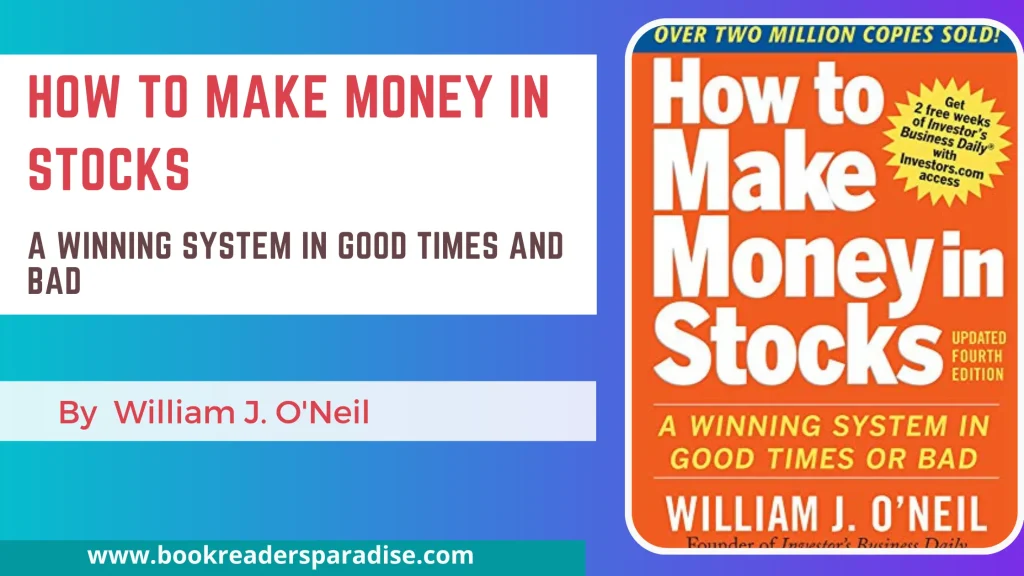How to Make Money in Stocks PDF : Investing in the stock market can be a daunting challenge for many individuals. With so many companies, stocks, and market trends to keep up with, it can feel like something that only the pros can accomplish.
However, with the right knowledge and guidance, anyone can learn to invest wisely and build their wealth over time. That’s where William J. O’Neil’s book, “How to Make Money in Stocks: A Winning System in Good Times and Bad” comes in. This national bestseller has empowered over 2 million investors with the secrets to building wealth through his powerful CAN SLIM® Investing System.
In this blog, we will review the key insights from this book and explain why it’s a must-read for anyone looking to succeed in the stock market.
Title How to Make Money in Stocks (Fourth Edition): A Winning System in Good Times and Bad Author William J. O'Neil Publication Date June 8, 2009 Genre ISBN 0071614133 Language English Total Pages 464 Audiobook Duration 11 hours and 50 minutes Rating
Also Read: The Uncertainty Solution PDF, Summary, and Audiobook FREE Download Details
What is the How to Make Money in Stocks PDF Book About?
“How to Make Money in Stocks: A Winning System in Good Times and Bad, Fourth Edition” is a book by William J. O’Neil that details a comprehensive investment strategy for the stock market.
Drawing from extensive research and analysis of successful investors and top-performing stocks since 1880, this book presents a powerful system for identifying and investing in winning stocks.
It covers topics such as how to analyze financial statements, spot market trends, and make informed investment decisions. The new edition of the book also includes updated examples and case studies to reflect the current market conditions.
Whether you’re a seasoned investor or just starting out, this book is an essential resource for learning how to grow your wealth through smart and strategic investments.
Also Read: The Wealth Decision PDF, Summary, and Audiobook FREE Download Details
Who is the author of the book How to Make Money in Stocks? – William J. O’Neil
William J. O’Neil is an accomplished American entrepreneur, stockbroker, and author. He founded the brokerage firm William O’Neil & Co. Inc in 1963 and the influential business newspaper Investors Business Daily in 1984.
His pioneering use of computers to analyze market trends and make investment decisions revolutionized the field of stock market analysis.
He is widely recognized for his expertise in investing and has authored several best-selling books on the topic, including “How to Make Money in Stocks: A Winning System in Good Times and Bad, Fourth Edition.” His story is both inspiring and educational, serving as a testament to the power of hard work, dedication, and innovative thinking.
Who Can Benefit from How to Make Money in Stocks PDF Book?
Whether you’re a seasoned investor or just starting out, “How to Make Money in Stocks: A Winning System in Good Times and Bad, Fourth Edition” offers valuable insights and practical advice for anyone looking to achieve financial freedom through the stock market.
The book is based on William J. O’Neil’s extensive research and analysis of successful investors and top-performing stocks dating back to 1880. It provides a thorough investment strategy that anyone can use, regardless of their level of knowledge or expertise.
With clear examples, updated case studies, and expert guidance, this book is a must-read for anyone looking to build their wealth through smart and strategic investments.
Also Read: Reading Price Charts Bar by Bar PDF, Summary, and Audiobook FREE Download Details
How to Make Money in Stocks PDF, Summary, and Book Review
Using SLIM to Invest in Stocks for Maximum Profit
Are you seeking the best investment strategies to make the most of stock market success? Look no further than William O’Neal’s 2009 book “How to Make Money in Stocks.” This book has sold over two million copies despite the unfavorable conditions of the financial crisis and market meltdown.
O’Neal and his team have identified key factors for selecting stocks with the greatest performance potential, including the SLIM method. SLIM is an acronym for: current quarterly earnings and sales; annual earnings increases; new products, management, or conditions; supply and demand; leaders (not laggards); institutional sponsorship.
Let’s take a closer look at each factor. First and foremost, current quarterly earnings per share compared to last year’s same quarter growth must be at least 20%, with an average of 70%.
To ensure this isn’t just a fluke, also look at three-year annual earnings growth averages of 25%. Additionally, it is important to analyze new products that beat competitors or create new markets, a new CEO with quality leadership skills, or changed industry conditions like shortages due to war or technological advancements.
The price of stocks is determined through supply and demand principles, favoring companies undertaking stock repurchase programs where top management is also a shareholder.
Investing only in leading players within strong industry sector groups ensures better quarterly as well as annual profits than their competition can provide. Lastly, institutions driving large volumes of demand make ideal investments, so seek out those stocks favored by institutional investors.
By following these SLIM investing strategies, and analyzing market indicators and pivot points, you will be able to maximize your profits from your investments in stocks!
Also Read: The Big Myth PDF, Summary, and Audiobook FREE Download Details
Understanding Market Direction with CANSLIM and Market Indicators
Are you a stock trader trying to understand the direction of the market? Asset management institutions hold positions in stocks, which impact their price increases. Consequently, comprehending market direction is essential for successful stock trading and investing.
Investors can assess relevant indices such as S&P Global 1200 or Nasdaq Composite for American companies to understand current market trends. Additionally, using CANSLIM principles, traders can identify indicators that suggest the markets are trending towards bear or bull markets.
Bear markets entail increasing volumes with declining prices, while bull markets demonstrate the opposite pattern, with decreasing volumes and rising prices.
Other signs indicating a bearish trend include increased optimism, despite poor economic conditions and a trader’s consistent success on recent investments made during such periods, respectively.
Moreover, traders can observe four to five days of “distribution” over the span of 4-5 weeks, indicating that a bull market may be ending.
Observing attempts at rally recovery (price increase plus higher volume) for 3-6 days, followed by a “follow-through” on day 4-7, can end a bear market trend or even reverse it if present conditions continue long enough for a change in sentiment and behavior among investors in a given asset class or geographical zone/ country-wide/region-wide basis, etc.
By tracking these indicators closely, investors can stay ahead of the curve and make informed decisions about where to invest their money next, ensuring greater returns with less risk!
Also Read: It’s OK to Be Angry About Capitalism PDF, Summary, Audiobook FREE Download Details
Evaluating Stock Investments Using the ‘Cup with Handle’ Pattern
“It is no secret that the stock market can be a tricky place to invest.” With so much to consider, it can be hard to make decisions without proper analysis and knowledge. Fortunately, charts and other data-driven metrics are useful tools for analyzing conditions or making decisions in almost every field of study, including investing in stocks.
By examining the price and volume patterns of a particular stock, investors can determine whether they should buy or sell it. One profitable pattern is the ‘cup with handle’ pattern, consisting of a 7- to 65-week base, a 12- to 30% decline, an upward rally with increased daily trading volumes (usually between 40% and 50%), an uptrend break, 10 weeks of tightness (smaller highs and lows), and increased pre-pattern price and trading volumes (> 30%).
The William O’Neil-developed SLIM system is a popular tool for investors to find potential investments that might outperform their peers. SLIM stands for:
C – Current Quarterly Earnings;
A – Annual Earnings Growth;
N – New Products/Services;
S – Supply & Demand;
L – Leaders/Laggards in Market;
I – Institutional Sponsorship & Investment Trends;
M – Market Direction.
By evaluating these indicators, along with pivot points (which represent potential turning points in the performance of an investment), investors may be able to identify good opportunities for investing in stocks based on their individual risk aversion levels and preferences.
In addition to SLIM and pivot points, other useful patterns besides the cup with handle exist that may better suit individual investors’ preferences or styles when deciding on their investments.
These include triangular formations where prices form higher lows over time, or chart patterns like head and shoulders, which indicate trend reversals from bearish markets back into bullish ones.
By considering all this information, investors can make more informed decisions about their stock investments – increasing their chances for success!”
Also Read: How to Grow Your Small Business PDF, Summary, Audiobook FREE Download Details
The Benefits of Loss Prevention for Stock Market Success
Loss prevention is a critical component of stock market success. To maximize gains and minimize losses, it’s important to cut losses short and avoid large losses.
Holding onto stocks that have dropped below their purchase price can be a costly mistake, as larger gains are required to break even for every point lost in the market. Selling when a stock drops below its purchase price is key. It’s also important to find stocks that pass SLIM analysis and come from a strong base, such as the cup without a handle or double bottom formations, to avoid sudden losses.
Aside from SLIM analysis, nine situations may call for selling, such as news affecting the stock value or deteriorating company fundamentals.
Strategies like these can help maximize profits and minimize risks associated with trading in the stock market. Understanding loss prevention and analyzing market indicators can lead to success in investing.
Creating an Effective Exit Plan for Stock Trading
Investing in the stock market can be lucrative, but knowing when to exit a position to maximize profits and minimize losses is crucial. Therefore, investors must create an effective exit plan when trading stocks.
One way to do this is by establishing a plan for determining when to sell the stock after buying it. Waiting for the stock to return to its highs can be risky, as market conditions may change or earnings results may deteriorate.
Heavy daily volume without further gains in a short period of time is a sign that it might be time to sell, as this could signal that distribution has begun and suggest selling off positions before any major losses occur.
Stocks surging through their upper channel line after long advances or creating new highs on poor volume could also signal potential weakness and an opportunity to sell the stock before significant losses occur.
When a stock repeatedly closes at its lowest price range of the day, caution should be exercised, and selling holdings should be considered if still invested in that particular security.
Poor relative strength compared to other stocks in its index or lone ranger status within its industry group could also suggest that the stock price may not continue to increase, and investing resources elsewhere would be wise before major losses occur due to the lack of previous growth.
Before investing, study various metrics such as the SLIM test and recognize bull/bear markets with tools available from financial websites to maximize profits while minimizing the likelihood of a loss occurring from incorrect decisions made while trading securities.
Additionally, look out for strong bases forming, which often predict future success when invested correctly into companies offering these opportunities. When wrong, identify limits and cut losses by exiting positions once percentages drop below 7-8% from previously reached buy points.
Always have an exit plan ready to avoid getting caught up emotionally while making trades. Instead, rely on a logical decision-making process developed over extended periods, adhering closely to how experienced investors act in similar situations.
Proper preparation based on research, including analysis done through studying criteria like SLIM, market indicators, and pivot points, can set investors up well ahead of time and reduce the likelihood of making errors while trading stocks as part of a long-term investment strategy employed throughout their professional finance career.
Also Read: The 9L’s PDF, Summary, Audiobook FREE Download Details
How to Achieve Your Goals and Succeed
Achieving your goals is essential for success, which can lead to life-changing opportunities. Whether you’re an investor maximizing your profits or just starting with stock market trading, there are strategies that can help you reach success in the market. This article will explore SLIM, Market Indicators and Pivot Points for informed stock investing decisions.
Goal setting creates a roadmap for future success by prioritizing and aligning our efforts. By understanding the difference between winning and reaching our goals, we can set realistic expectations and make better decisions. Developing an action plan provides clarity and purpose to reach final destinations.
Tracking progress is essential to ensure objectives are met and identifying areas needing extra attention or support. Establishing measurable milestones with specific deadlines keeps motivation levels high and prevents procrastination.
Celebrating small wins encourages future success and learning from mistakes.
Would I recommend the How to Make Money in Stocks book to others?
If you’re interested in the stock market and looking to grow your wealth through smart and strategic investments, I would highly recommend reading “How to Make Money in Stocks: A Winning System in Good Times and Bad, Fourth Edition.” The book offers valuable insights and practical advice on how to identify and invest in winning stocks, including adopting a buy-and-hold strategy for long-term growth.
With its clear examples and expert guidance, this book is an essential resource for anyone looking to achieve financial freedom through stock market investments.
Also Read: Breaking Through PDF, Summary, and Audiobook FREE Download Details
Top 5 Reasons Why You Should Read How to Make Money in Stocks Book?
If you’re interested in growing your wealth through the stock market, here are the top 5 reasons why you should read “How to Make Money in Stocks: A Winning System in Good Times and Bad, Fourth Edition”:
- Learn to adopt a buy-and-hold strategy- This book is based on the principle that long-term investing is the key to success in the stock market. By reading it, you’ll gain valuable insights on how to identify winning stocks and hold them for the long haul.
- Get expert guidance – William J. O’Neil shares his extensive experience and expertise in the field of stock market analysis, offering practical advice on how to invest in stocks effectively.
- Understand various ways to make money- You’ll gain a better understanding of the different strategies for making money in stocks, including selling at a profit, short selling, and staying invested for the long term.
- Identify top-performing stocks – The book presents a comprehensive investment strategy that’s been proven effective over the course of more than 100 years of data analysis, giving you the tools to identify top-performing stocks.
- Achieve financial freedom – By following the strategies outlined in this book, you’ll be on your way to achieving financial freedom through smart and strategic stock market investments.
Also Read: Entrepreneurial Leap PDF, Summary, and Audiobook FREE Download Details
Where Can I Download How to Make Money in Stocks PDF/Ebook/Audiobook/Epub Free?
If you’re interested in learning how to make money in stocks, “How to Make Money in Stocks: A Winning System in Good Times and Bad, Fourth Edition” is a must-read.
The book presents a comprehensive investment strategy based on data analysis and proven methods, including adopting a buy-and-hold strategy for long-term growth.
To make the most of the valuable insights and practical advice presented in the book, consider downloading the audiobook version.
This will allow you to listen to the book on the go and gain a better understanding of the strategies without having to physically read the book.
By learning about the three ways to make money in stocks—selling at a profit, short selling, and staying invested for the long term—you’ll be on your way to achieving financial freedom through smart and strategic stock market investments.
You can download the How to Make Money in Stocks audiobook for completely FREE from the below-mentioned link.
Website Paid / Free Free Free
Also Read:
- Nomad Capitalist PDF, Summary, and Audiobook FREE Download Details
- Awaken Your Genius PDF, Summary, Audiobook FREE Download Details
- Scaling People PDF, Summary, and Audiobook FREE Download Details – By Claire Hughes Johnson
- I’m Not Yelling PDF, Summary, and Audiobook FREE Download Details
- Two Weeks Notice PDF, Summary, and Audiobook FREE Download Details



